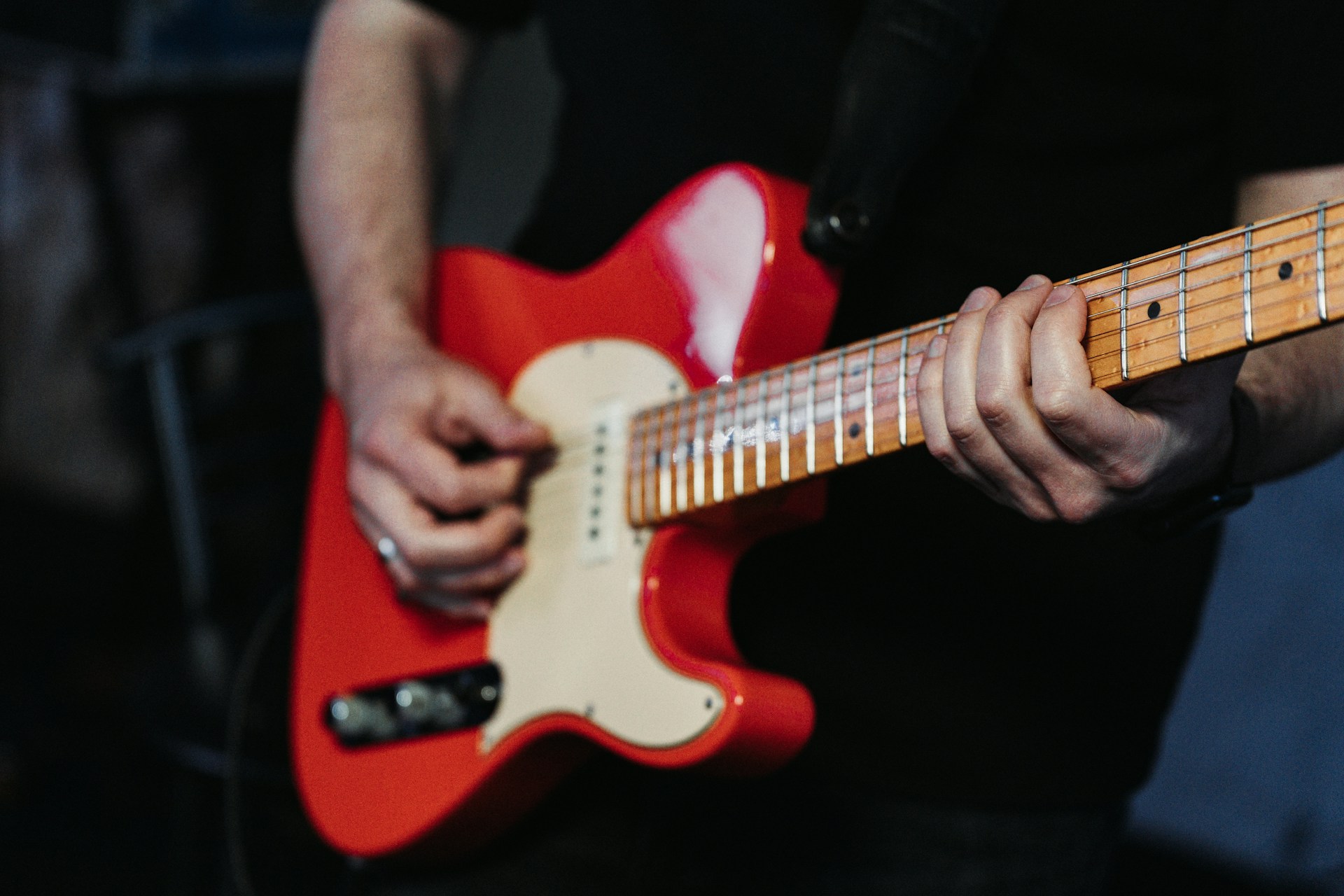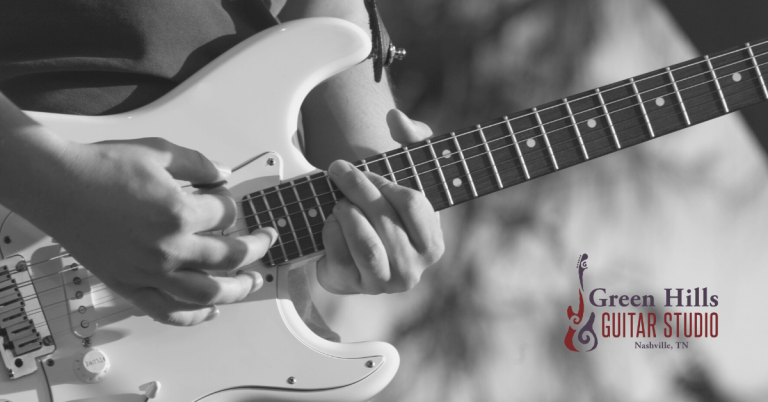Moveable Major Scale Patterns for Guitar
When you learn guitar, you enter a world of techniques and concepts. Understanding moveable major scale patterns is key to leveling up your musical skills. These patterns are like your trusty GPS, making it a breeze to navigate the fretboard and play in any key.
This isn’t just geared towards beginners. Many intermediate guitarists never fully grasp the importance of the major scale. Writing it off as “easy” in an effort to skip to the front of the line. But this limited thinking is why many intermediate players never become advanced players.
In this article, we’ll present five moveable major scale patterns that are essential for every guitarist. Learning how each pattern connects will enable you to explore every key like a local.
Taking the time to internalize these moveable major scale patterns isn’t just something you should consider—it’s fundamental. These patterns are capable of opening doors to musical exploration, innovation, and growth.
Let’s get into it!
Why Learn Scales on Guitar?
Learning scales on the guitar is more than busy work to help you shred—it’s fundamental to musical understanding and versatility. Scales serve as the building blocks for chord progressions, melody construction, and overall musical expression.
Consider the iconic opening riff of Led Zeppelin’s “Stairway to Heaven” (I know, no Stairway…) or the melodic improvisations of jazz legends like John Coltrane—rooted deeply in scale knowledge.
With a deep understanding of the major scale, guitarists can gain the tools to navigate various musical contexts, from crafting catchy melodies to laying down complex chord progressions.
So, while soloing is often the prescribed reason for practicing scales, scales are the backstage crew, essential for setting the stage for musical greatness.
How Scales Relate To Music Theory
Understanding how scales relate to music theory is essential for any aspiring musician. Imagine music theory as the map guiding you through the musical landscape. Scales are the landmarks that help you navigate this terrain with confidence.
Diatonic harmony, a fancy term for the chords derived from a scale, might sound daunting, but it’s simply the collection of chords that naturally fit within a given scale. Think of it as the colors on your palette when painting a musical picture.
By mastering the major scale and its relationship to music theory, you’re equipping yourself with the tools to create beautiful musical landscapes, whether you’re strumming chords around a campfire or shredding a blistering guitar solo on stage.
For more about scale patterns, check out our article on the five moveable pentatonic scale patterns!
Major Scale Construction
The major scale is a diatonic scale that progresses through pitches in a specific two-tone (whole step/half step) pattern without skipping any note names.
A step denotes the distance between two notes. On the guitar, a whole step equals two frets, while a half step equals one fret, also known as semitones.
The whole step/half-step pattern for the major scale follows this sequence:
- Whole – Whole – Half – Whole – Whole – Whole – Half
This is often abbreviated as:
- W – W – H – W – W – W – H
Example: the F major scale:
- F to G: whole step (F – Gb – G)
- G to A: whole step (G – Ab – A)
- A to Bb: half step (A – Bb)
- Bb to C: whole step (Bb – B – C)
- C to D: whole step (C – Db – D)
- D to E: whole step (D – Eb – E)
- E to F: half step (E – F)
This pattern is true for all major scales and is a blueprint for forming scales in any key. One of the guitar’s benefits (and curses) is that scale patterns are moveable. See the Circle of Fifths diagram below to learn more about key relationships.
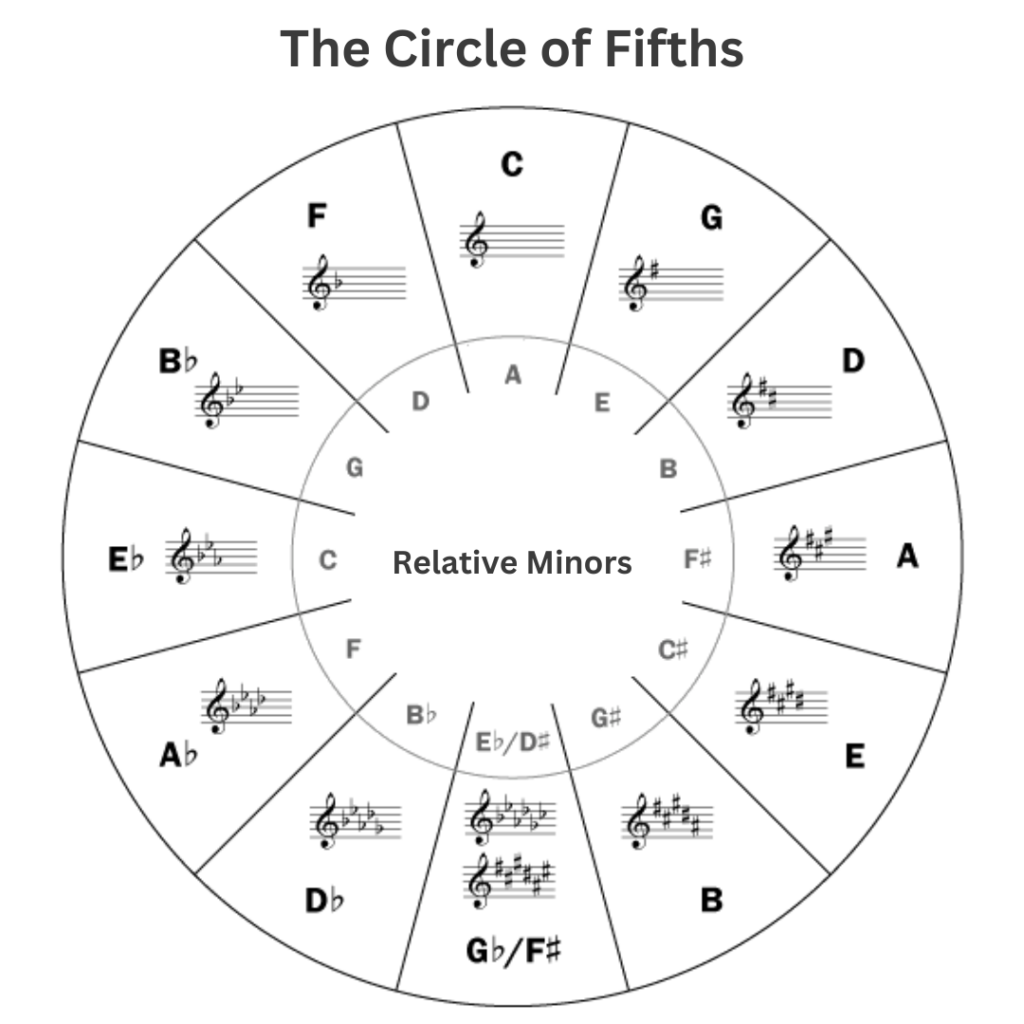
Understanding Interval Qualities in the Major Scale
Intervals, the spaces between notes, are the foundational building blocks of music theory and diatonic harmony. Each interval possesses a unique quality that determines the character of a scale and influences its musical expression.
In the major scale, the intervals are as follows:
- Root: Establishes the tonic note and serves as the foundation of the scale.
- 2nd: Creates a sense of motion and brightness, harmonizing with the root to form a classic major sound.
- Major 3rd: Defines the major quality of the scale, imparting a cheerful and uplifting character.
- Perfect 4th: Adds stability and resolution, often used to transition between phrases or chords.
- Perfect 5th: Contributes to the scale’s stability and consonance, forming the basis of power chords and harmonies.
- 6th (relative minor): Introduces color and variation, lending melodies a sense of sweetness and richness.
- 7th: Imparts a sense of tension and anticipation, often resolving to the root to complete the scale.
Understanding these interval qualities is paramount, as they dictate the scale’s structure and sonic characteristics. Importantly, while the notes of a major scale may vary depending on the key, the interval qualities remain consistent. This concept allows for creating movable shapes and patterns across the fretboard, facilitating fluidity and versatility in playing.
In essence, grasping interval qualities empowers guitarists to unlock a world of musical possibilities. By recognizing these intervals within the major scale, players can navigate the fretboard with confidence and precision, creating rich harmonies and melodic lines that captivate listeners.
Now, let’s explore the major scale positions and patterns that embody these interval qualities, empowering you to elevate your guitar playing to new heights.
Major Scale Patterns and Positions on the Guitar Fretboard
Picture the guitar fretboard as a vast interconnected grid. Within this grid lie patterns of notes, and where there are note patterns, scale patterns are waiting to be explored. Understanding these patterns is key because it allows you to traverse the entire fretboard like a pro!
The following moveable scale patterns are diagramed according to intervals, reinforcing their applicability to all major scales. This approach also emphasizes the importance of intervals as foundational elements of music theory.
1. Major Scale Position 1
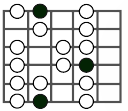
Starting with the root note of your chosen key, play each note of the scale in sequence across the fretboard, ascending and descending. For practice, include all notes of the pattern, starting and ending on the root note.
Note the root note pattern within this position, which forms a triangle on the fretboard. This pattern serves as a helpful guide for navigating scale positions.
2. Major Scale Position 2
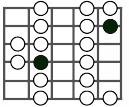
In position 2, root notes are located on strings 4 and 2, resulting in two root notes within this position. Practice the scale starting from the root note, ascending and descending.
Notice how this position connects with position 1 via specific notes on frets 4 and 5. While the frets may vary for different major scales, the association between positions remains consistent.
3. Major Scale Position 3
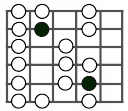
Position 3 features root notes on strings 2 and 5, comprising two root notes within this position. Pay attention to the root note patterns and note the connecting notes with the previous position.
4. Major Scale Position 4
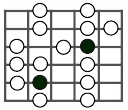
Moving up the fretboard to position 4, you’ll find root notes on strings 3 and 5, once again totaling two root notes within this position.
5. Major Scale Position 5
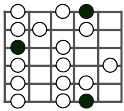
Like position 1, position 5 includes three root notes due to their placement on strings 6 and 1. This position also involves a shift, so follow the suggested fingerings closely.
Remember, these scale patterns are movable. You can play any major scale using the same pattern by shifting the root note up or down the fretboard.
The Coda
In conclusion, mastering moveable major scale patterns opens up a world of possibilities for guitarists of all levels. These patterns are the foundation for understanding music theory, navigating the fretboard like a pro, and unlocking creative expression in your playing.
Whether you’re a beginner looking to expand your musical horizons or an experienced guitarist seeking to refine your skills, investing time in learning moveable major scale patterns is invaluable to your musical growth.
If you’re ready to improve your guitar playing, consider enrolling in lessons at Green Hills Guitar Studio. Located in the heart of Nashville or available online, our experienced instructors are dedicated to helping you achieve your musical goals. Contact us today to schedule your first guitar lesson!

